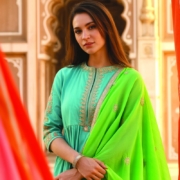Ways How Eastern Wear Has Evolved Over The Years
Due to its deep roots in history, culture, and regional variation, eastern clothing has long been an essential component of Pakistani identity. Pakistani fashion has changed significantly throughout time, fusing traditional practices with contemporary design. Fashion has changed to reflect not only shifting styles but also social, economic, and technical changes. From unstitched fabrics to ready-to-wear ensembles, and from the classic shalwar kameez to contemporary fusion styles, Pakistani Eastern dress has evolved into a dynamic form of self-expression that cuts across generations.
The Shift in Silhouettes
The wide-legged gharara, flowy anarkali dresses and highly flared lehengas were examples of loose-fitting traditional Pakistani clothing. Conversely, in recent years more fitting and structured shapes have gained popularity. Women now frequently choose straight-cut shirts, cigarette pants, and peplum tops because they look polished and modern. Men’s kurtas are still necessary, but thinner cuts and contemporary tailoring methods have given them a more refined appearance by replacing excessively loose fits.
Introduction of Minimalism
Rich materials, elaborate embroidery and stitching, and vivid colors have long been employed in Eastern dress to convey joy and refinement. Although those features are still prevalent in formal and bridal textiles, there has been a discernible shift toward simplicity. These days, designers tend to use clean lines, delicate colors, and modest experimentation. In addition to expressing a sense of contemporary international fashion, minimalism acknowledges that contemporary Pakistani women would rather live elegantly in their daily lives.
Fusion of Eastern and Western Styles
Another key transformation in Pakistani eastern wear is the seamless integration of Western elements. Jackets, palazzos, crop tops, and capes are now staples of eastern fashion. In order to produce distinctive items that appeal to young people, Pakistani designers have effectively combined Western cuts with traditional textiles like organza, chiffon, and khaddar. This hybrid trend speaks to Pakistan’s multicultural population by reflecting a multinational identity while also expanding style options.
Changing Fabric Choices
Pakistani fashion has always been dominated by fabrics like silk, jamawar and banarsi, particularly at festivals and weddings. Although these are still in style, fabrics that are breathable and suitable for many seasons have become more popular. Thanks to designer lawn collections, lawn, a summertime essential, has transformed from a simple cotton fabric to an opulent necessity. With printed and embroidered alternatives, linen and khaddar dominate the market in the winter, making eastern clothing year-round fashionable and weather appropriate.
Rise of Designer and Pret Wear
The days of Eastern clothing being either handmade or tailored are long gone. Pakistan’s fashion scene has seen a radical change with the emergence of ready-to-wear (pret) collections. Accessible fashion lines that blend comfort and style have been produced by companies including Sana Safinaz, Khaadi, and Maria B. By providing a broad range of alternatives from casual to semi-formal, these ready-made collections encourage more people to experiment with fashion without having to deal with the headache of custom tailoring.
Influence of Media and Celebrities
Eastern clothing has been transformed and modernized in large part because to the media. What individuals dress is greatly influenced by social media influencers, fashion shows, television dramas, and celebrities. Famous television looks often become national trends that affect not only how individuals dress but also how they see dress that is proper for their culture. From Sajal Aly’s stunning shalwar kameez ensembles to Mahira Khan’s elegant saris, celebrities continue to set the bar for contemporary eastern fashion.
Cultural Reclamation and Revival
Interestingly, there is a revived desire to resurrect old skills and practices despite the modernization of eastern clothing. Traditional needlework techniques like gota, tilla, mirror work and ajrak prints are being actively incorporated into collections by designers. In addition to preserving Pakistan’s rich textile legacy, this cultural reclamation teaches the next generation about their ancestry. Fashion becomes a vehicle for creativity and preservation when it gives traditional arts a modern spin.
Global Accessibility and Online Reach
The digital era has also contributed significantly to the evolution of eastern wear. Pakistani apparel is no longer just found at backyard sales because of the growth of e-commerce. Brands can serve the global diaspora and help them stay linked to their cultural roots by offering feasible international shipping. Social media and online fashion platforms have all democratized the industry. It allows independent designers and small firms to express their creativity and potentially reach a global audience.
Conclusion
The fashion narrative of Pakistani eastern wear has evolved from traditional styles to a contemporary, ever-changing one. The designs have grown more inclusive, adaptable, and globally relevant while maintaining the core of cultural identity. Whether viewed through the prisms of creativity, cultural pride, or minimalism, eastern clothing keeps developing, enabling people to express themselves while maintaining ties to their roots. In addition to reflecting shifts in style, this dynamic journey of transition tells the tale of a nation evolving over time.

